Arecaceae
Some plants are so iconic that they’ve basically become flagship representatives for entire ecosystems.
Fleshy, machete-hackable vines make you think of the jungle, prickly cacti are reminiscent of deserts, and the humble palm tree has pretty much become synonymous with warm beaches.
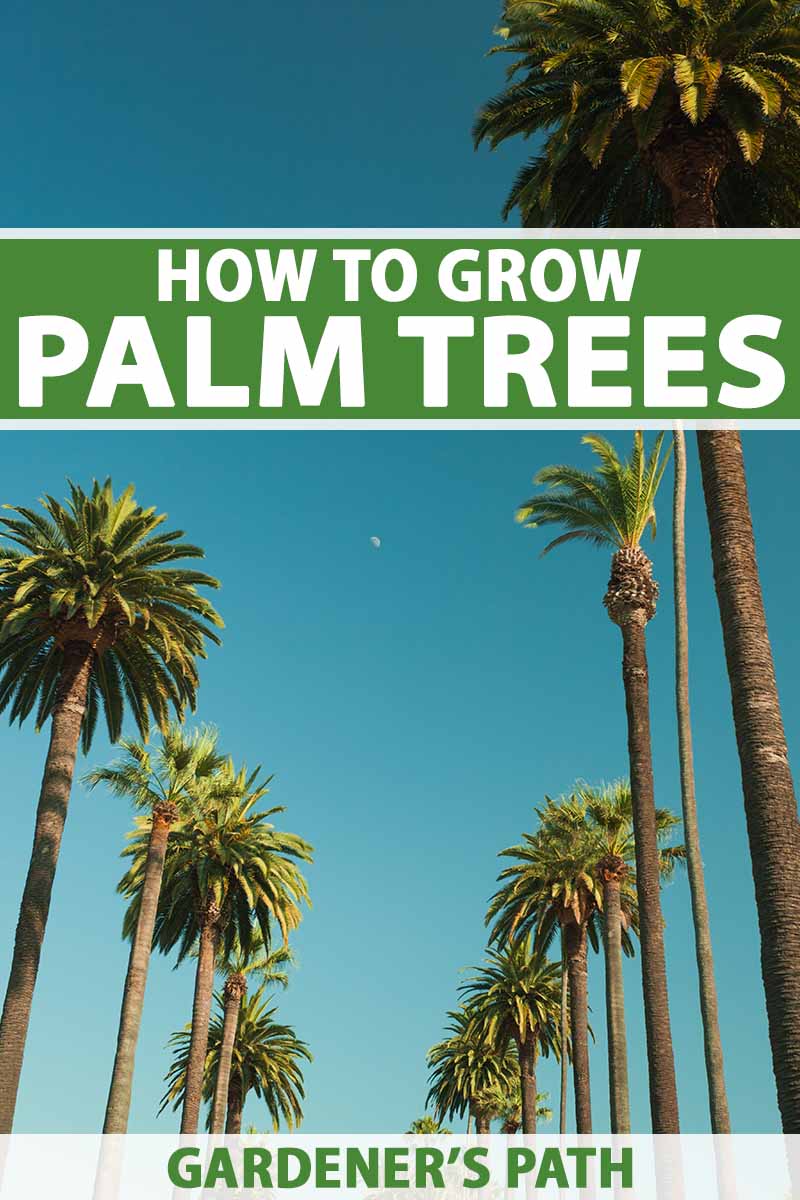
We link to vendors to help you find relevant products. If you buy from one of our links, we may earn a commission.
But in the case of palm trees, solely associating them with sandy coastlines doesn’t give these gorgeous plants enough credit.
Originating from tropical and subtropical climates the world over, members of the Arecaceae family can be found growing across a diverse range of habitats, from tropical rainforests to desert oases, and even to mountainous areas.
When you consider their uniquely beautiful aesthetic, it’s obvious that palm trees are an essential planting for any green thumb looking to inject some tropical vibes into their garden.
And with so many different species available, there’s a specimen for practically every landscape. But how should a gardener go about caring for them?
In this guide, we’ll break down everything a hopeful palm tree grower needs to know.
By the end, you’ll be well trained in the ways of the Arecaceae family. Plus, you’ll probably have a renewed appreciation for these plants!
Your journey begins here:
What You’ll Learn
What Are Palm Trees?
Belonging to the Arecales order of flowering plants, the Arecaceae or Palmae family consists of over 200 genera and 2,600 species.
Palms can be found on every continent save for Antarctica, and hardy in USDA Zones ranging from 6 to 13.

It’s easy to confuse palms with cycads, which are actually significantly different in spite of their similar appearance.
While palms are flowering angiosperms, cycads are gymnosperms, which produce naked seeds sans fruit. Despite its name, the sago palm is one such cycad that folks often confuse for an actual palm.
Specifically, palm trees are the ones with a tree-like form, as opposed to the shrub-like and climbing habits of other species. But since the “tree status” of palm trees is botanically up in the air, the info to come in this guide should be applicable to non-tree palms, too.
“Hold up… what? Whaddaya mean, palm trees aren’t exactly trees?!?”
I know, I know. It’s a bit complicated, so let me explain.
To Tree or Not to Tree
Whether or not you view a palm tree as a true tree depends on your definition of “tree.”
If you consider a tree to be a tall perennial plant with roots, stems, and leaves, then yes, a palm tree qualifies…
I mean, arborists care for them, so why wouldn’t they be trees? Well, true trees do things a bit differently from members of the Arecaceae family.
True dicotyledonous trees have a layer of vascular cambium, a section of dividing cells that produce phloem tissue going outwards, towards the bark, while also producing xylem tissue going inwards, towards the stem.
Once it matures, the inner layer of secondary xylem is known as wood, which gives the tree trunk added girth, increased structural support, and its trademark age-indicating rings.
Palm trees, however, are monocots, which physiologically makes them more like grasses and bamboo than your typical landscape trees. Throughout their cross-sections are distinct vascular bundles of xylem and phloem, which are reinforced by strong, tear-resistant fibers.
These bundles allow for bending without breaking in the presence of high winds, which really comes in handy during harsh storms.
But as a result of not having organized vascular cambiums, the trunks of palm trees don’t grow out, only up… Plus, they don’t produce bark or true wood, all of which calls their “tree” status into question.
But at the end of the day, it doesn’t matter too much, so please don’t be a know-it-all goober who gives an unsolicited lecture whenever somebody says “palm tree.”
The trunks of palm trees tend to grow straight up or with a slight curve, whether they’re solitary or growing in multiple clumps.
The trunks are very tough, with a smooth to rough texture. All leaves grow from a single growing point – known as a bud or heart – and as old leaves die, the leaf bases are left behind, hardening on the trunk.
Arecaceae leaves are evergreen, and they appear in varying sizes.
Most have a sheath, a leafstalk, and a blade, and they’re typically feather-like, fan-shaped, or something in between. But other shapes exist, too.

Palm trees can be monoecious or dioecious, and their inflorescences can be complex panicles or spike-like single bracts, with varying bloom times and frequencies. As with the leaves, the flowers are diverse in form, color, and dimensions.
After pollination by wind and/or animals, the flowers give way to drupes, with each fruit bearing one or more seeds.
The smallest of these fruits can be a mere quarter-inch in diameter, while the largest can be a 40-pound coconut.
Much like their trunks, their roots can’t increase in girth, but they can travel quite far underground. Typically growing laterally, these roots are all technically adventitious – fun fact!
Cultivation and History
Although you’re probably here for their aesthetics, palm trees aren’t just lookers.
Depending on the species, they’re also useful for many non-ornamental applications… and they have been for quite a while.
Take the date palm, for instance – this plant has been cultivated by humans for over 6,000 years for its delicious, hyper-sugary fruits.
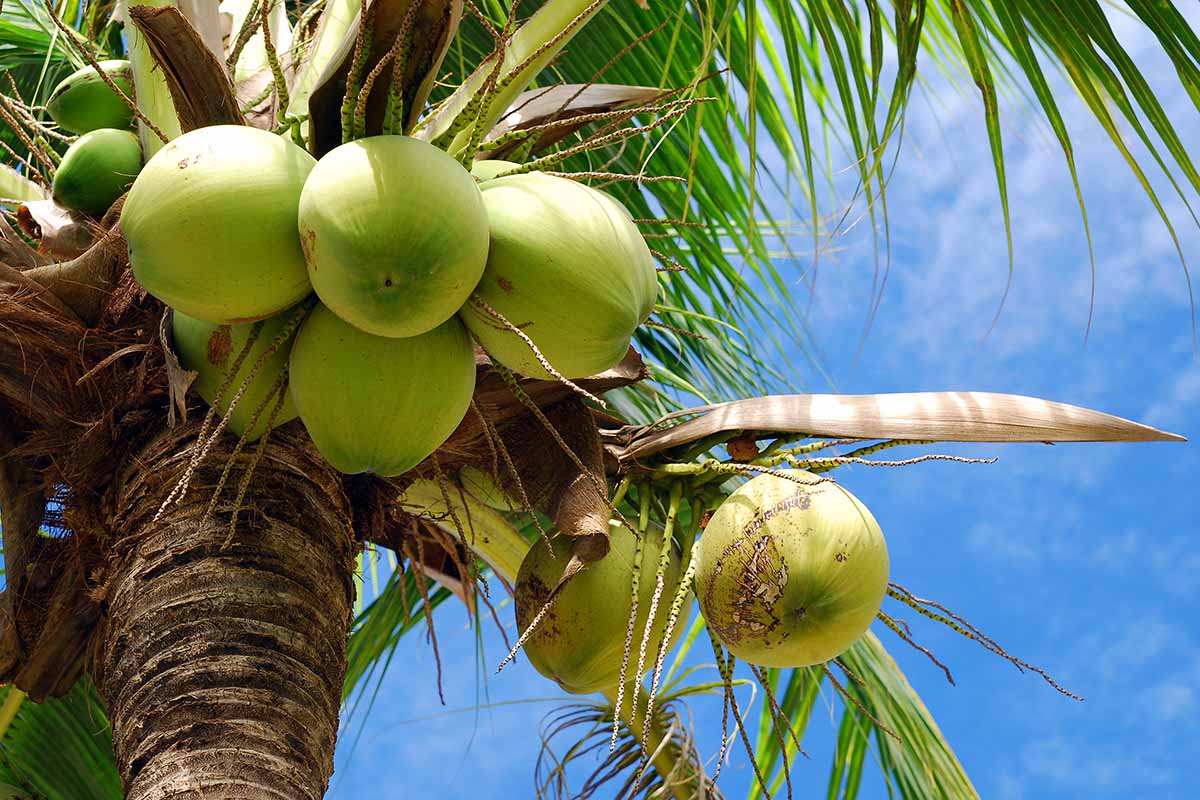
Other significant species for humanity include the African oil palm and the coconut.
The former comes in handy for its palm and kernel oils, while the latter yields coir, fuel, nutritious fats, delicious juices, and more.
Many species of the Arecaceae can yield sugars, alcohols, and starches, whether they’re acquired from the flowers, fruits, or even the pith.
The tough trunks can be used to make weapons, construct buildings, and yield wax. In skillful hands, the leaves are excellent materials for making books, hammocks, baskets, and rain-blocking paraphernalia such as rain capes and umbrellas.
Species of palm have provided humans with many essentials for living in the tropics, with entire communities depending on them for their survival or livelihood.
On a global scale, these plants are very commercially important and economically valuable. And I’m barely scratching the surface of their utility here – entire books have been written on the subject.
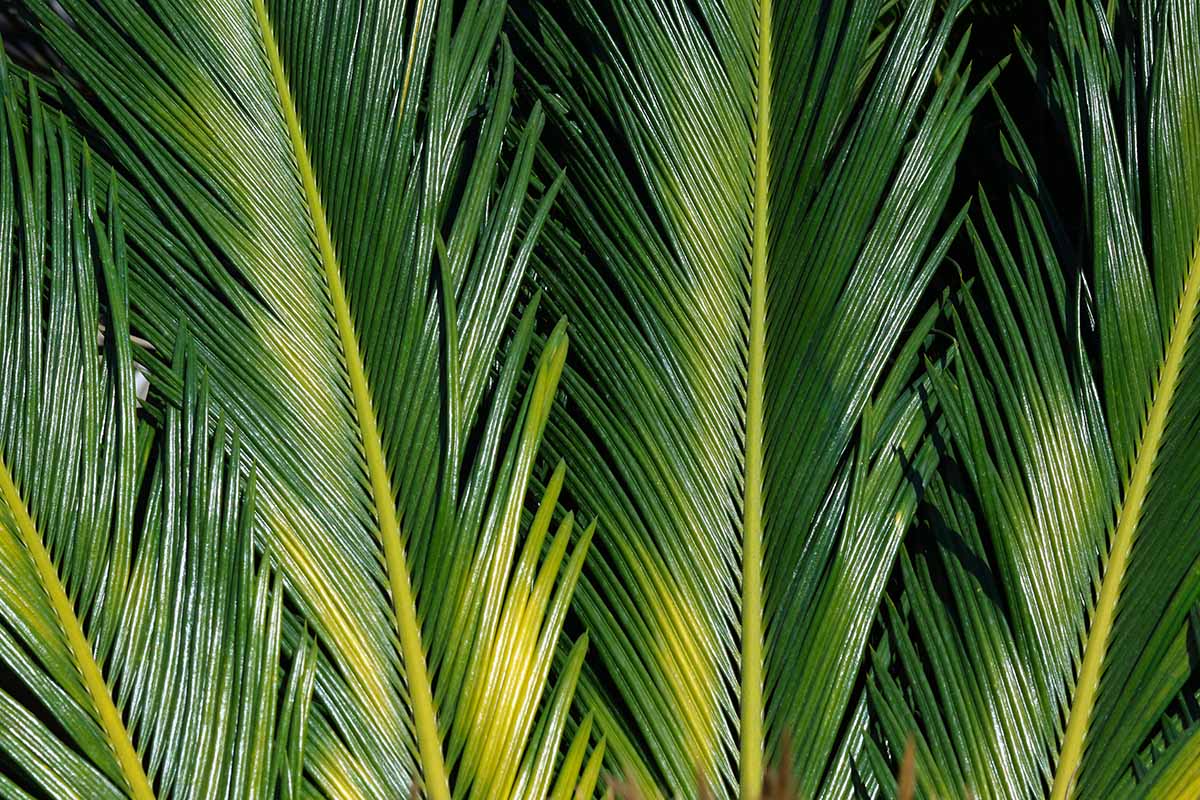
Culturally, palm fronds are symbols of virtues such as peace, victory, and fertility.
Plus, they have significance in many religions, from the Mesopotamian beliefs of the past to the Abrahamic faiths of the present. And as I mentioned earlier, they’ve come to represent all things beach.
To put a bow on all of this, I think Carl Linneaus was right on the money when he called the palm “the prince of plants.”
Palm Propagation
Due to their unique physiology, palm trees can’t be propagated from cuttings or via grafting the way other trees can.
Therefore, you’ll instead have to sow seeds, divide established plants, or transplant a potted specimen.
From Seed
First things first: you need seeds. They can be purchased, gathered, or acquired from a friend. In a pinch, acquisition from a frenemy is also acceptable.
But the fresher, the better – to check, you can slice open a seed and take a look. If the inside is rotten or foul-smelling, pitch it. If you find firm freshness without discoloration, you’re good to go.
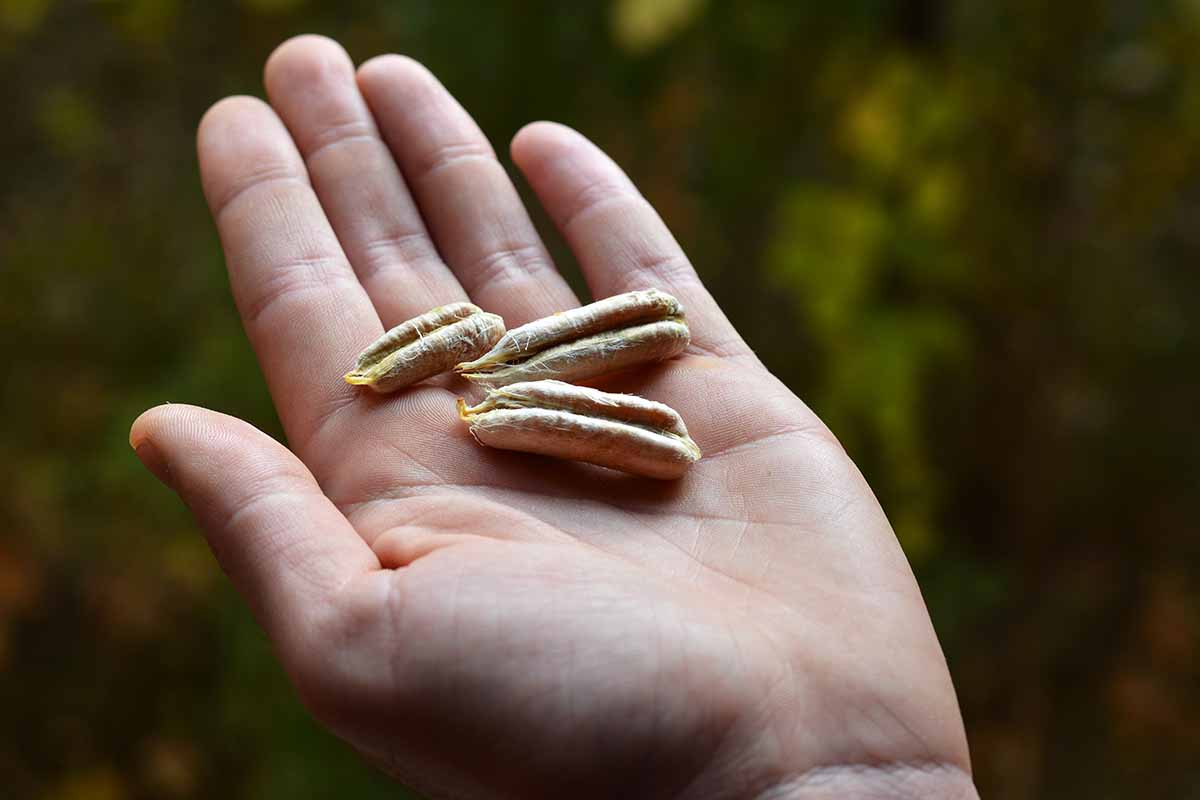
Slightly immature seeds should be kept in a tightly sealed plastic bag that’s left out in a warm spot for a week or so.
Once you have ripe, ready-to-go seeds, soak them for 48 to 72 hours, making sure to change the water each day. Then, de-pulp the seeds with a knife or finely-meshed screen.
Then, soak the seeds for an additional 24 hours. The keepers will sink, while the duds will float. Keep the former and pitch the latter.
Fill three-inch containers – although you may need something larger, if your seeds are unusually large – with a 50:50 mix of peat moss and perlite, then sow a seed in each. Depth-wise, make it so the seeds are positioned half their diameter deep.
Place the containers in light conditions that they prefer as adults – full sun species should receive a lot of light, and vice versa for more shady species.
Also, make sure that they receive temperatures of 80 to 95°F. This is best provided either in a greenhouse, or on sunny windowsill with a bottom heat mat.
For a heat mat that adds 10 to 20 degrees of heat to the ambient temperature, visit Gardener’s Supply.
Keep the media moist, but not wet, throughout the germination process. Germinating these seeds can take a long time – think months, not weeks – so patience is key.
Anywhere between germination and the formation of one to two leaves, seedlings can be transplanted. Try and transplant during the warmer months, if possible.

But before you transplant, you should harden off the seedlings. To do this, leave the seedlings outside for 30 to 60 minutes before bringing them back inside.
Each successive day, add an additional half to full hour of exposure time until the seedlings can spend a full day outside.
Okay, now you can transplant.
Via Division
Dividing a palm tree is pretty simple, thankfully. But you’ll need to select a multi-stemmed (and preferably small) one, as dividing a single stem will kill it.
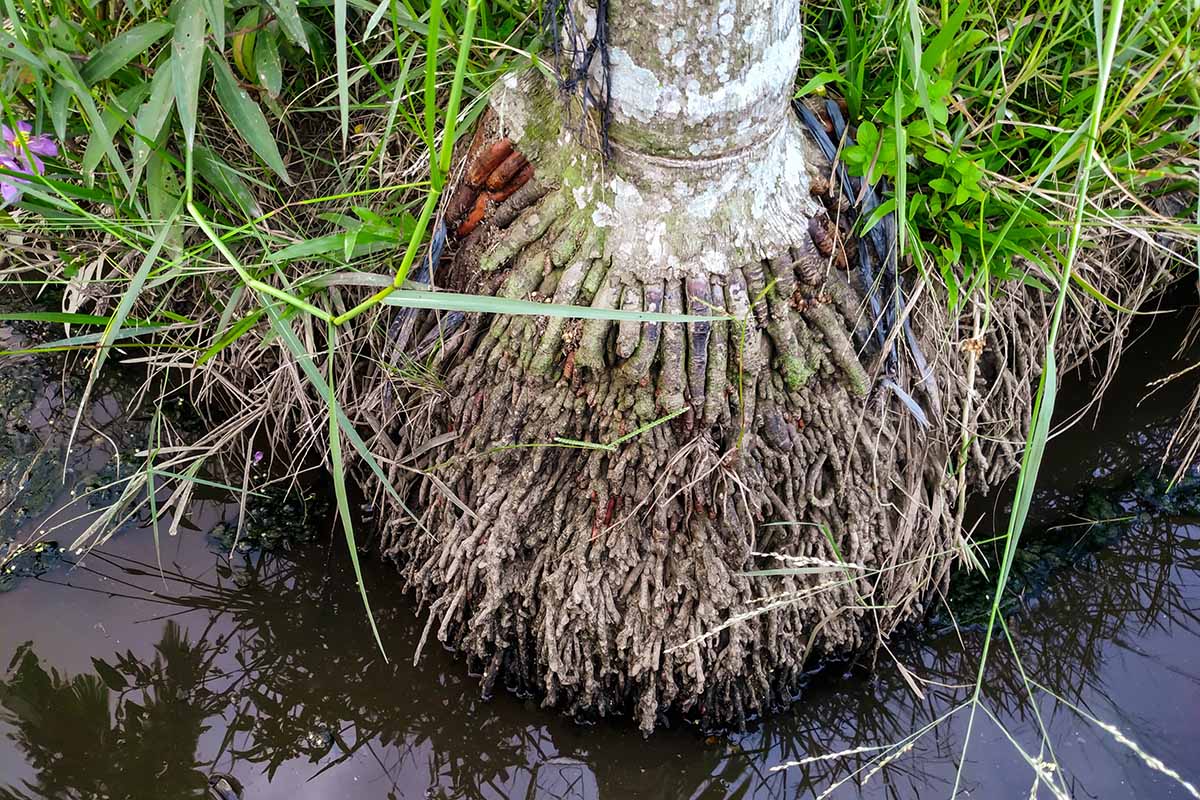
In early spring, lift your to-be-divided plant, brush away the loose soil from its roots, and lay it out on a tarp.
With a sharp and sterilized blade, divide the roots into your preferred number of daughter plants, making sure to leave a stem intact with each root mass.
From here, you should be good for transplanting!
From Seedlings/Transplanting
Come spring to early summer, select planting sites of loose, light, and coarse soil such as a sandy loam. Proper drainage and a pH of 5.5 to 7.5 are both essential.
Space the planting sites about as far apart as you’d expect your transplants to spread at maturity.
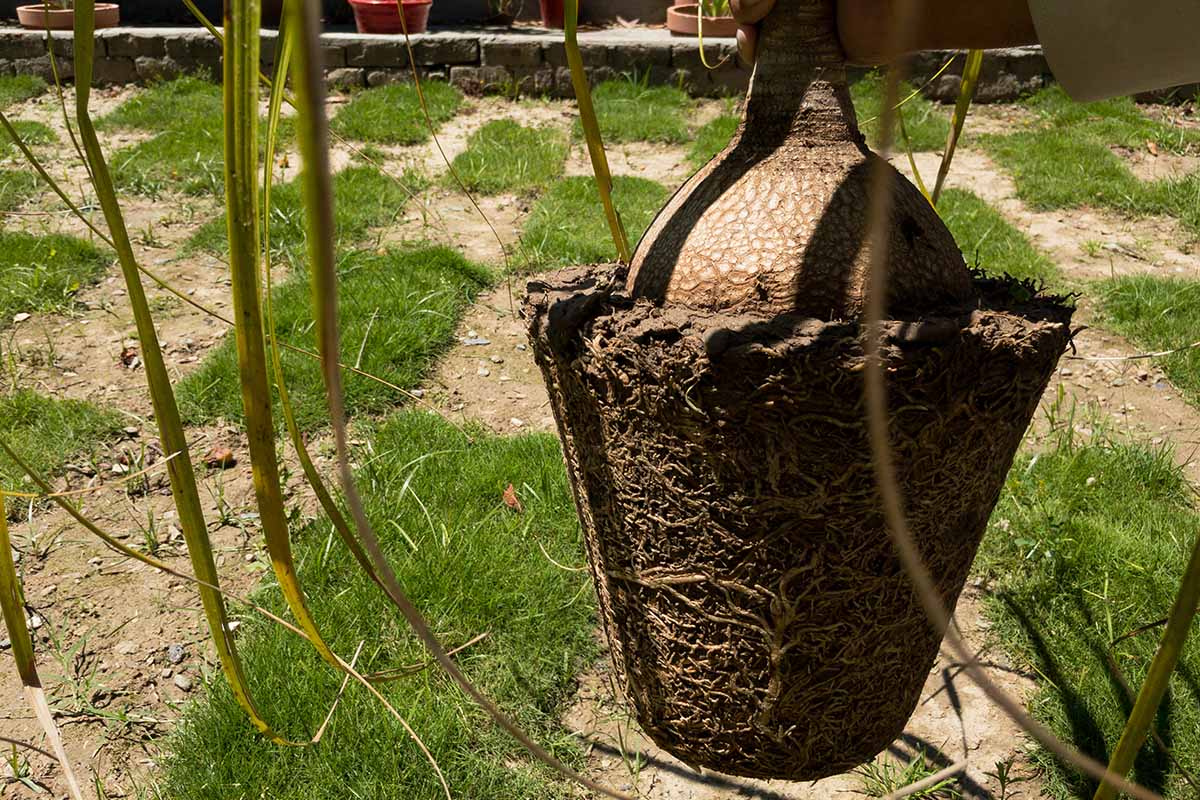
Dig holes that are just as deep and a bit wider than the root systems of your transplants. Loosen the transplants from their containers, lower them into their holes, then backfill with dug-out soil.
For some added fertility, you can work some organic matter into the dug-out soil beforehand.
If you’re transplanting into another container, same deal. A 50:50 mix of peat moss and perlite should do the trick. Make sure the containers have drainage holes!
Water in the transplant sites deeply after transplanting, and be diligent in keeping the soil evenly moist for the first four to six months after transplanting.
How to Grow Palm Trees
Now that you’ve got a palm tree in the ground or in a container, let’s learn how to keep it alive and beautifully swayin’ in the wind.
Climate and Exposure Needs
If you’re located in USDA Hardiness Zones 6 to 13, there’s a palm tree that can grow in your landscape!
It may be wise to opt for a container-grown specimen, though, if you’re located on the edge of the hardiness range for your chosen species. That way, you can bring it indoors as needed.

You’ll need to do some species-specific research to find out what level of exposure your plant needs. Full sun, shade-loving… there’s a palm for almost every scenario!
In general, these plants tolerate wind and salt, so no need to worry too much about stiff breezes or any salt spray from a nearby ocean.
Soil Needs
Well-draining soil with a light, coarse texture and a pH of 5.5 to 7.5 is an absolute must. If you’re looking for a specific texture, sandy loam is perfect.
Water and Fertilizer Needs
As a general rule, make sure to water your palm whenever the top three inches or so of the soil dries out. But be sure to adjust based on the moisture requirements of the specific species that you’re growing.
Once the tree has established itself, a fertilizer that’s designed for palms should be added at regular intervals throughout the growing season, according to product instructions.
Make sure to spread the fertilizer out to the canopy’s drip line, while also keeping it about a foot away from the trunk.
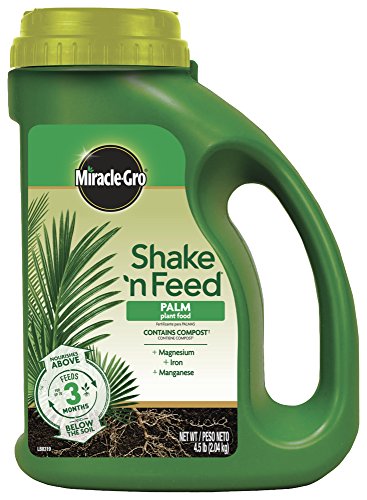
If you need a granular, OMRI-certified organic fertilizer that nourishes palm trees very well, try this four-pound bag of 4-2-4 NPK fertilizer from Jobe’s Organics, available via Amazon.
Growing Tips
- If you’re in USDA Hardiness Zones 6 to13, you can find a hardy specimen for your area.
- Make sure to provide proper soil drainage.
- In general, irrigate whenever the top three inches of soil are dry.
Pruning and Maintenance
Whenever you happen to notice dead, dying, or diseased fronds or frond skirts, they should be pruned away ASAP, if at all possible. Make sure to use sharp and sterile blades while doing so.
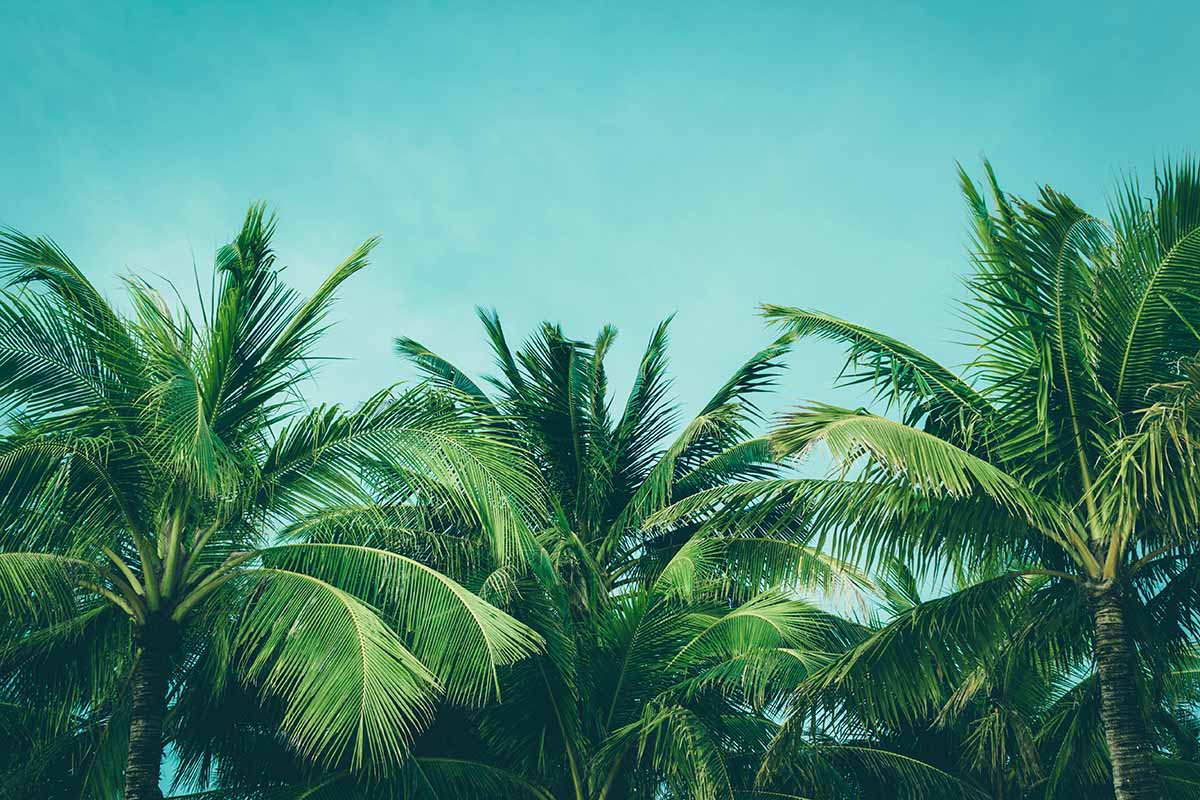
A mulch layer that’s two to four inches thick can do wonders for moisture retention.
Don’t pile it against the trunk, though – make sure to keep it at least a couple inches away, preferably more like a foot.
If you don’t want messy fruit or seed heads left all over your landscape, remove the inflorescences before they develop.
Any fallen leaves, fruits, or other structures should be raked up as they accumulate on the ground.
Species of Palms to Select
The sheer amount of Arecaceae species could send any potential buyer into severe fits of paralysis-by-analysis.
With these four selections, you have a nice base of dependable palm trees from which to explore other attractive options, if desired.
European Fan
Native across the European mainland from Spain to Italy, Chamaerops humilis flaunts small, spiny-stalked, and fan-shaped leaves from skinny and gently curving trunks.
With a hardiness range of USDA Zones 8 to 11, the European fan palm reaches mature heights of eight to 15 feet with a spread of six to 10 feet.
This full-sun plant blooms with clusters of small, round, and cream-colored inflorescences from spring to summer, and it is drought-tolerant after establishment.
If you want to enjoy a mid-sized mound of fronds for many delightful years, C. humilis is for you.
The European fan palm is available in three-gallon containers from PlantingTree.com.
Pindo
Also known as the jelly palm, Butia odorata reaches heights of 15 to 20 feet, with curved and feather-like grayish-green leaves that can reach lengths of four to six feet.
These trees also flaunt yellow to orange-red flowers, and have a hardiness range from USDA Zone 8 to 11.
For a disease-resistant specimen that looks pretty fly beneath power lines, behold the pindo palm. For one – or more – of your own, check out PlantingTree.com.
Pygmy Date
Reaching dimensions of 12 feet in height and six to eight feet in width when fully grown, Phoenix roebelenii, or the pygmy date, is a smaller version of the full-sized P. dactylifera.
Hardy in USDA Zones 9 to 11, this single-stemmed tree bursts with inconspicuous white flowers and green, feathery fronds that reach three to five feet in length, each with eight- to 12-inch leaflets.
Even the trunk looks cool, what with its covering of peg-like leaf bases.
Producing small dates, these guys are delicious and delightful additions to any landscape. You can acquire plants in three- or five-gallon containers from FastGrowingTrees.com.
Sylvester
Another member of the Phoenix genus, P. sylvestris is the wild-growing, blueish green- to silvery green-leafed counterpart to the aforementioned P. dactylifera.
Reaching 10- to 15-foot heights – although they can make it to 50 feet, in time – and eight- to 15-foot spreads at maturity, the Sylvester palm flaunts yellow and white inflorescences alongside leaves that can grow 10 feet long!
With a knobbed trunk to tie it all together, P. sylvestris is perfect for when you want a large specimen that lacks the typical green foliage of other palms.
If you’re interested, it’s available in three-gallon containers from FastGrowingTrees.com.
Windmill
Hardy in USDA Zones 7 to 11, Trachycarpus fortunei has a canopy that’s bursting with yellow and cream-colored blooms and green, fan-shaped fronds that are about a yardstick’s length wide.
With 18-inch petioles, these fronds are about what you’d picture ancient slaves fanning their ruler with, but that’s admittedly a tangent…
These palms typically reach 10 to 20 feet tall, but can grow to heights of 40 feet after a while. With a similarly narrow spread, this tree is perfect for sticking in tight growing spaces.
There’s a specimen in a #5 container with your name on it at Nature Hills Nursery.
Managing Pests and Disease
As a plant parent, one of the best ways of treating your fronded children well is to keep them safe from pests and pathogens. Let’s learn how!
Herbivores
As a whole, the Arecaceae family attracts a plethora of herbivorous vertebrates.
From the sky, you have birds and bats. From the ground, you have monkeys, lizards, squirrels, rats… the list goes on.
Depending on the animal in question, you may or may not want to do anything about them.
Having a variety of animals visit your plants is typically a good thing, but you may not appreciate the damage that they cause, such as munched-on-leaves or flowers.
So you must consider each animal on a case-by-case basis before enforcing the appropriate controls.
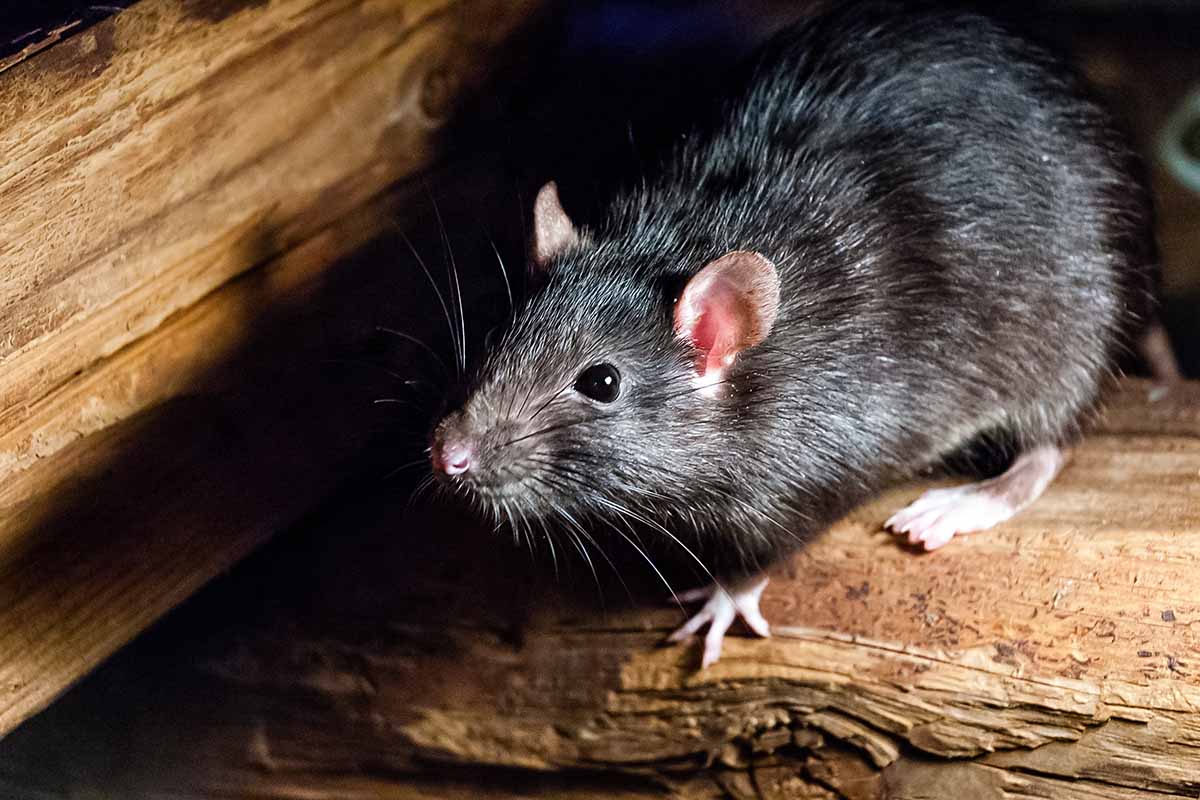
But I’d definitely recommend watching out for squirrels and rats, since they do more harm than good.
For palm trees, the best thing to do is to wrap a thin sheet of metal around the trunk, which will limit their ability to climb and cause damage.
Insects
Since insects can spread diseases, it’s doubly important to manage their presence.
If your palm in question is rather tall, you may need the help of a qualified plant health care specialist to help you reach the afflicted structures.
Of course, if you have mad climbing skills and ample health insurance, you could always scale the tree yourself, pruner blades in mouth like a pirate biting his dagger as he climbs up a schooner’s mast. But that’s definitely easier said than done.
Aphids
Small, soft-bodied, and armed with piercing-sucking mouthparts, aphids extract sap from plant tissues, which can lead to chlorosis, wilting, and possibly necrosis.
And let’s not forget about attracting ants and excreting sooty mold-forming honeydew.
Strong sprays of water can knock them off of plant surfaces, while horticultural oil can suffocate them.
For the latter, check out this organic product from Monterey, which is available from Arbico Organics in both ready-to-spray and concentrated forms.
Got problems with aphids? Check out our guide to learn more.
Mealybugs
Mealybugs are round-bodied insects that are covered in a white, cottony wax.
With piercing-sucking mouthparts, mealybugs extract plant fluids and excrete honeydew much like aphids do, which causes the above mentioned corresponding symptoms.
Heavily infested tissues should be pruned off, while sprays of water and horticultural oil can handle more moderate infestations.
And check out our guide to learn more about dealing with mealybugs.
Scale
Whether they come in soft-bodied or armored forms, scale insects are yet another type of small, round-bodied pest that extracts fluids from plant tissues while excreting honeydew.
Scale infestations can cause yellowing, wilting, and the dropping of fronds and lead to the death of the plant in severe cases.
Cotton swabs or cloths soaked in rubbing alcohol can handle light infestations, while horticultural oils and insecticidal soaps should do the trick for larger infestations.
For some ready-to-use insecticidal soap, check out what Bonide has to offer at Arbico Organics.
Read our guide to scale for more information.
Disease
Pathogens are quick to hitchhike, so be sure to make sterile tools and disease-free soils a staple of your gardening practice.
Fusarium Wilt
Caused by the Fusarium oxysporum fungus, Fusarium wilt is a deadly serious disease of certain palm trees such as P. canariensis, S. romanzoffiana, and W. robusta.
Traveling via air or infected tools, the causal fungus clogs up the plant xylem, which restricts the plant’s internal water flow.
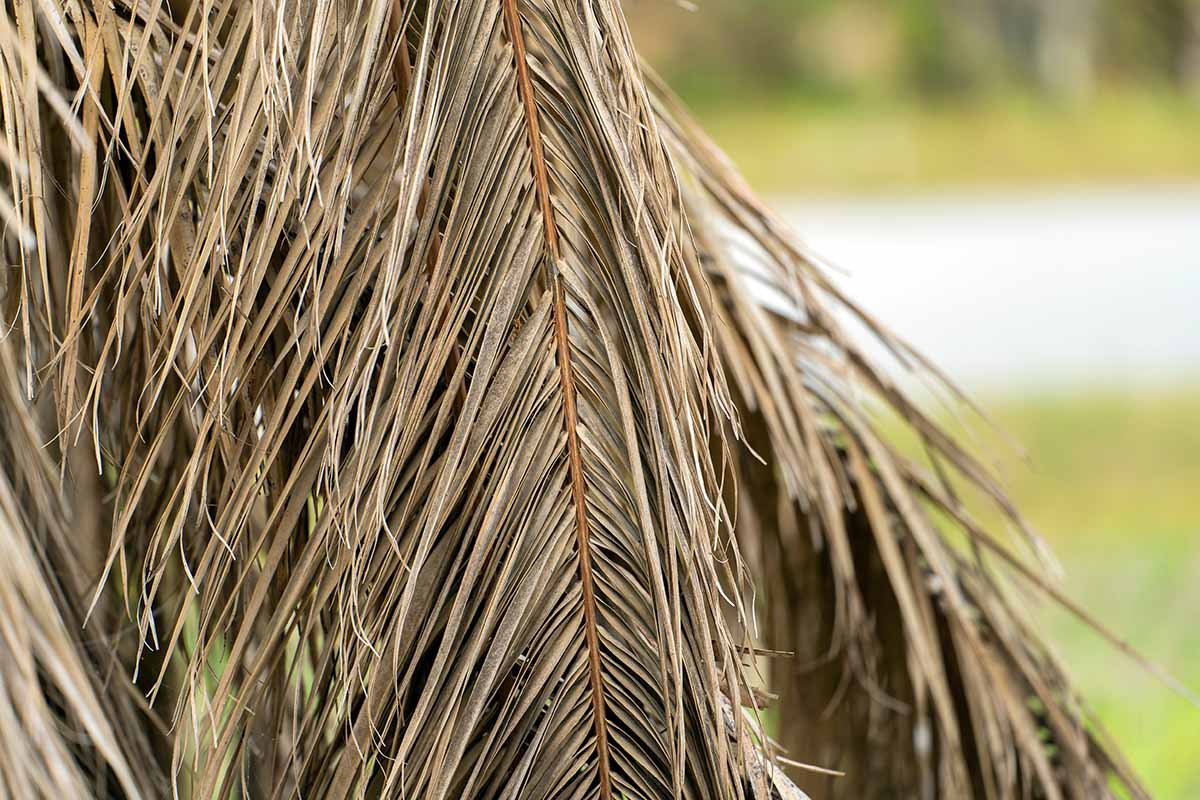
As a result, leaflets can begin to yellow and turn necrotic, and the plant could eventually die.
With no cure currently known, Fusarium wilt is best prevented by properly cleaning your tools in between prunings.
If infected plants perish, they should be removed and replaced with non-susceptible species such as pindo or queen palms, since the pathogen can linger in the soil.
Ganoderma Root and Butt Rot
Caused by Ganoderma zonatum fungi, Ganoderma root and butt rot is capable of infecting many different members of the Arecaceae family.
Symptoms begin with withering and drooping older fronds, and progress to stunted new growth that’s pale to chlorotically yellow. Even the roots can end up decayed, depending on where the pathogen entered the plant.
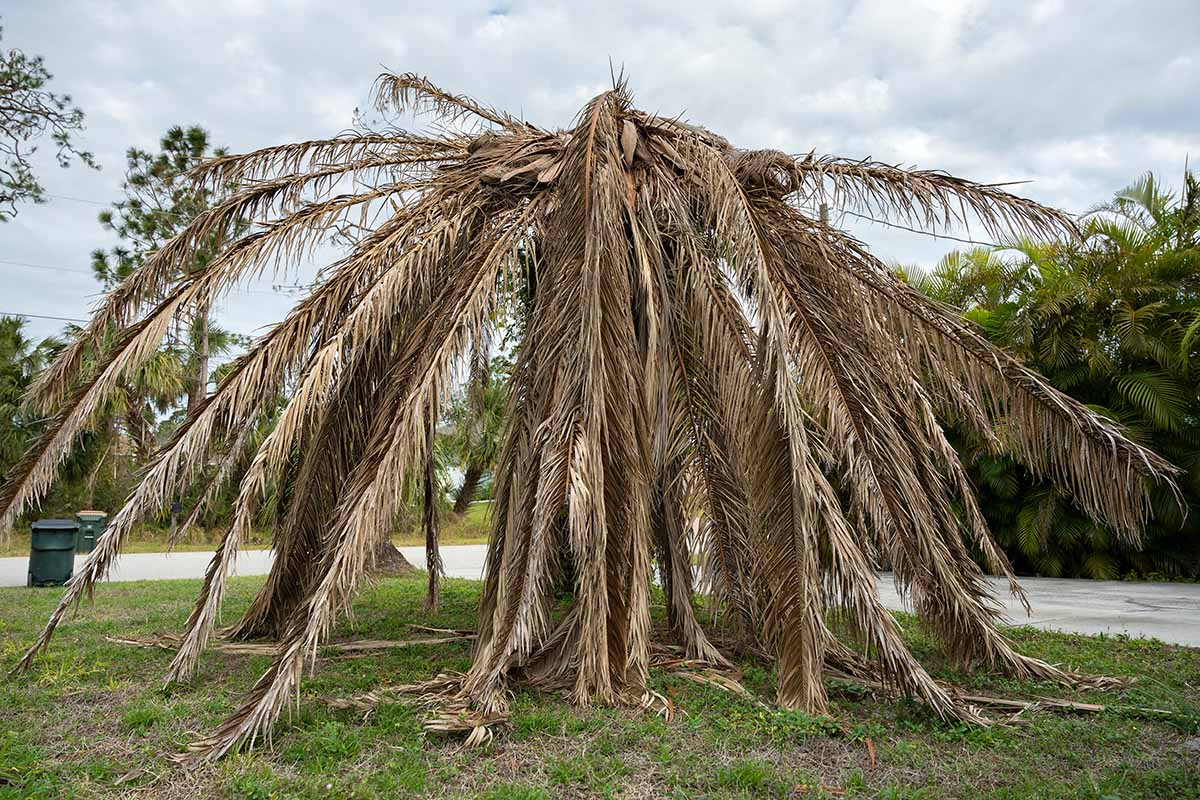
Thanks to rotted-out tissue within, infected trunks usually sound hollow when they’re tapped. Infected trees can die in three to four years, but not before developing spore-producing conks.
Make sure to avoid injuring healthy trunks, but be quick to remove any dead palms from your landscape.
If you have an infection on your hands, remove the tree and replace it with a non-palm.
Leaf Spot
Various types of fungi and bacteria can cause leaf spots, rounded and often dark spots on the leaves.
These take up valuable chlorophyllic real estate that the plant would otherwise use for photosynthesis.
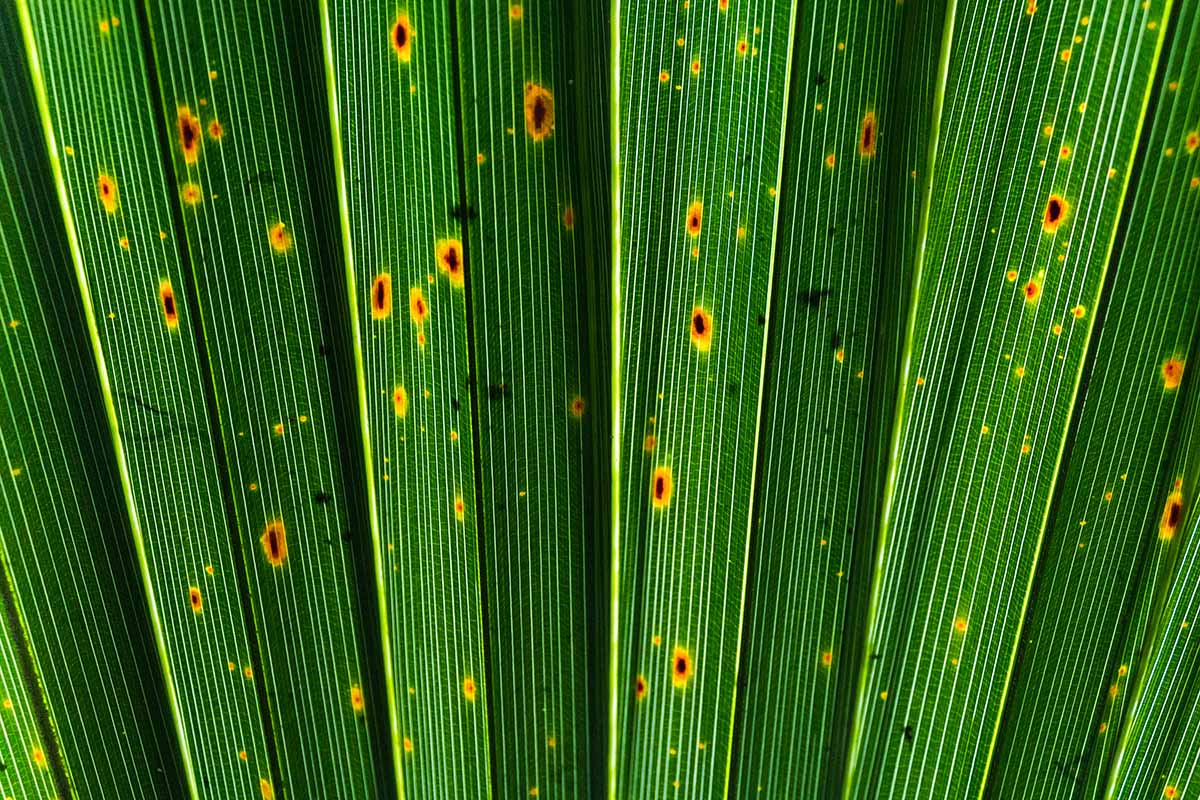
Avoiding overhead irrigation is a valuable preventative measure, along with adequate plant spacing.
If the majority of a leaf is spotted, then it should be pruned away. In the case of severe infections, fungicides can help to reduce further spread.
Best Uses for Palm Trees
Given the many different palm tree forms available, there are many different applications for them in the landscape.
You can grow them by themselves as solitary specimens or in clusters as grouped accents. The big ones can provide ample shade, while the small ones look wonderful in containers.

As many tropical resorts have figured out, the palm aesthetic conveys friendliness, warmth, and serenity.
If you’re after any of those vibes in your garden, then I’d suggest hopping aboard the Arecaceae train!
Quick Reference Growing Guide
| Plant Type: | Flowering evergreen monocotyledonous perennials | Flower/Foliage Color: | Green, orange, violet, white, yellow/various shades of green (all depending on species) |
| Native to: | Africa, Asia, Europe, North America, Oceania, South America | Maintenance: | Low to moderate |
| Hardiness (USDA Zones): | 6-13, depending on species | Tolerance: | Heat, salt, shade, wind (all depending on species) |
| Bloom Time/Season: | Varying bloom seasons and cycles | Soil Type: | Coarse, light, loose |
| Exposure: | Full sun to full shade | Soil pH: | 5.5-7.5 |
| Time to Maturity: | 5-10 years or more | Soil Drainage: | Well-draining |
| Spacing: | Width of mature spread | Attracts: | Birds, insect pollinators, various mammals and reptiles |
| Planting Depth: | Just below surface (seeds), depth of root system (transplants) | Uses: | Accents, container plantings, groupings, privacy plantings, shade, specimens |
| Height: | 2-200 feet | Order: | Arecales |
| Spread: | Up to 40 feet | Family: | Arecaceae |
| Water Needs: | Moderate | Genera: | Cocos, Phoenix, Roystonea, Sabal, Trachycarpus |
| Common Pests and Disease: | Aphids, mealybugs, scale; Fusarium wilt, Ganoderma root and butt rot, leaf spot | Species: | C. humilis, P. roebelenii, P. sylvestris, T. fortunei |
For a Sense of Calm, Try a Palm
Maybe I’m just biased because I’m a Midwesterner who’s never had a stressful time at the beach, but I really feel as if palm trees mellow you out a bit.
It’s hard to feel anxious in the shade of some tropical fronds, at least for me.

But these plants can also hype you up. I definitely get excited when I see them, since it usually means a fun vacation is about to begin!
But even if you never leave home, having some members of the Arecaceae around will really put a smile on your face.
If you’ve been accumulating questions and remarks throughout your time spent reading this guide, then the comments section is the perfect place to drop ’em off.
And if you’re looking for more information about growing landscape trees, have a read of these guides next:
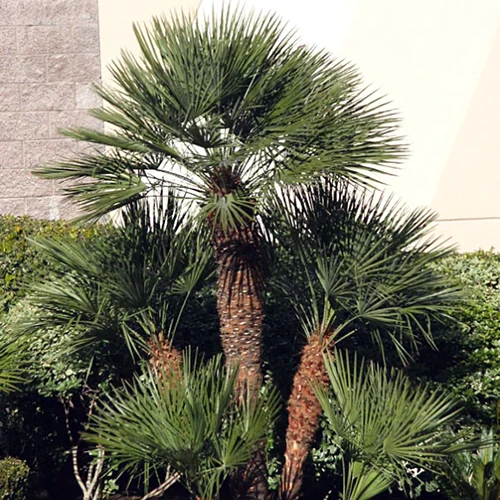
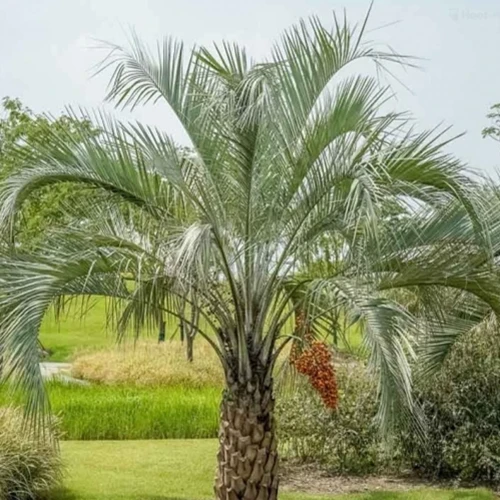
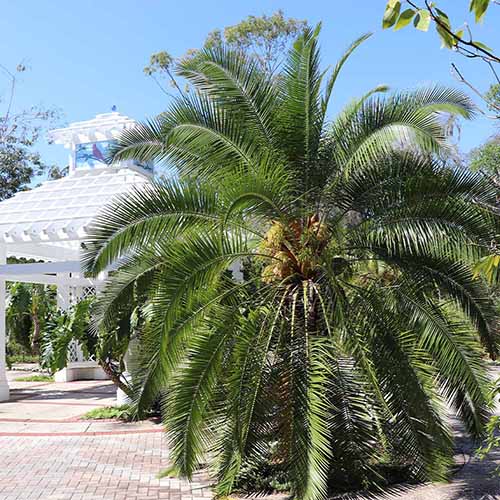

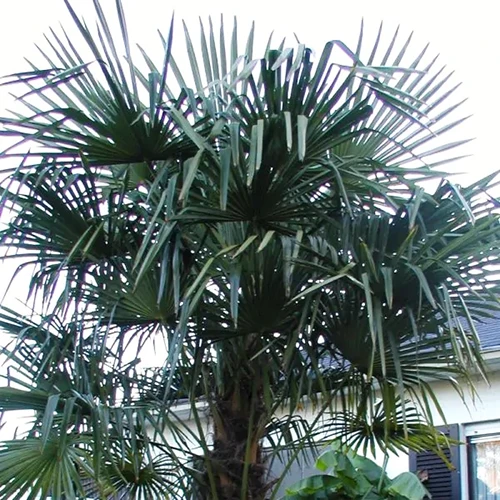
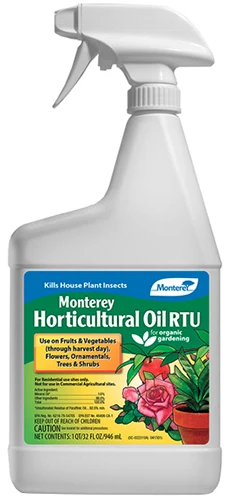
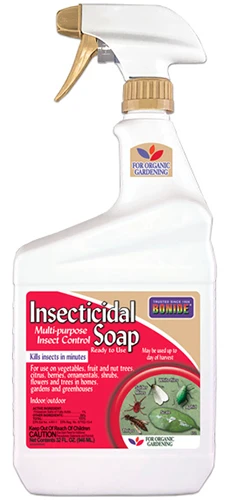
goodday trust you are well
Can you please assist my granny planted 2 small palm trees .I’m looking after them..could you please assist on identifying what type of palm tree they are.
Your help is greatly appreciated.thanks
Sure thing, Divan! The young age of the palm makes it a bit tricky, but I have some ideas. However, I’ll need a bit more information from you before I can say something definitive.
If you could also send a couple of close-up images of the fronds and a couple of close-up images of where the fronds meet the plant’s central stem, that would be great! It would also be helpful to know the state and hardiness zone of where these palms are located. Thanks!
I have a plam that I have taken off the lips do I need too Wrap the top
Nope, you should be good to leave it be!